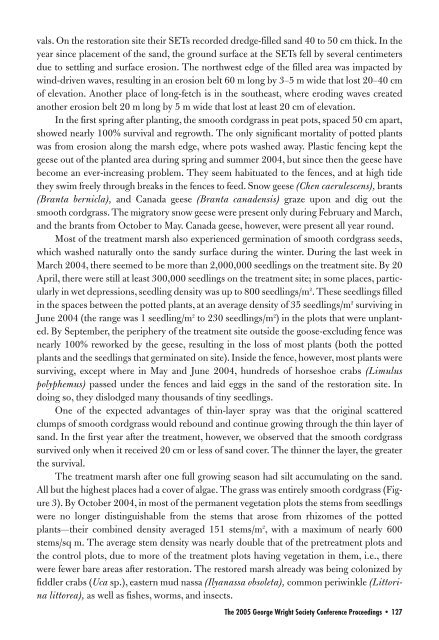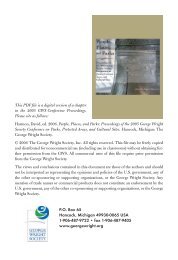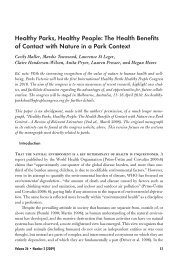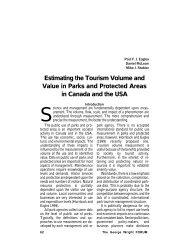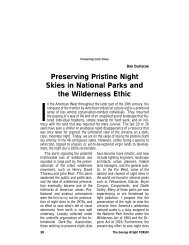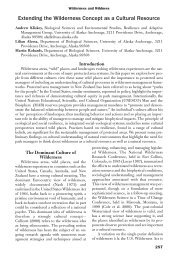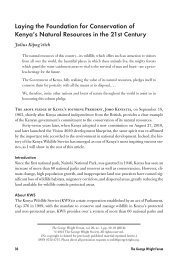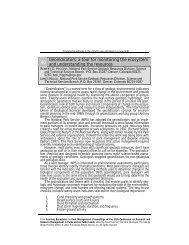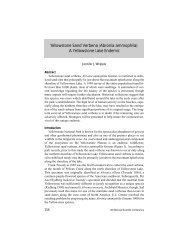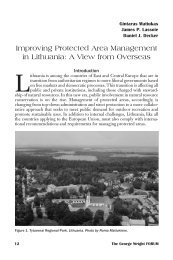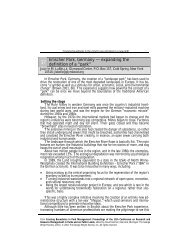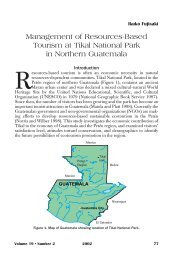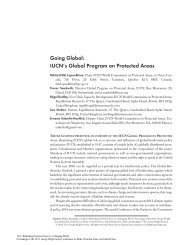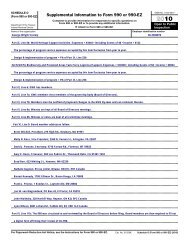Big Egg Marsh Experimental Restoration in Jamaica Bay
Big Egg Marsh Experimental Restoration in Jamaica Bay
Big Egg Marsh Experimental Restoration in Jamaica Bay
Create successful ePaper yourself
Turn your PDF publications into a flip-book with our unique Google optimized e-Paper software.
vals. On the restoration site their SETs recorded dredge-filled sand 40 to 50 cm thick. In the<br />
year s<strong>in</strong>ce placement of the sand, the ground surface at the SETs fell by several centimeters<br />
due to settl<strong>in</strong>g and surface erosion. The northwest edge of the filled area was impacted by<br />
w<strong>in</strong>d-driven waves, result<strong>in</strong>g <strong>in</strong> an erosion belt 60 m long by 3–5 m wide that lost 20–40 cm<br />
of elevation. Another place of long-fetch is <strong>in</strong> the southeast, where erod<strong>in</strong>g waves created<br />
another erosion belt 20 m long by 5 m wide that lost at least 20 cm of elevation.<br />
In the first spr<strong>in</strong>g after plant<strong>in</strong>g, the smooth cordgrass <strong>in</strong> peat pots, spaced 50 cm apart,<br />
showed nearly 100% survival and regrowth. The only significant mortality of potted plants<br />
was from erosion along the marsh edge, where pots washed away. Plastic fenc<strong>in</strong>g kept the<br />
geese out of the planted area dur<strong>in</strong>g spr<strong>in</strong>g and summer 2004, but s<strong>in</strong>ce then the geese have<br />
become an ever-<strong>in</strong>creas<strong>in</strong>g problem. They seem habituated to the fences, and at high tide<br />
they swim freely through breaks <strong>in</strong> the fences to feed. Snow geese (Chen caerulescens), brants<br />
(Branta bernicla), and Canada geese (Branta canadensis) graze upon and dig out the<br />
smooth cordgrass. The migratory snow geese were present only dur<strong>in</strong>g February and March,<br />
and the brants from October to May. Canada geese, however, were present all year round.<br />
Most of the treatment marsh also experienced germ<strong>in</strong>ation of smooth cordgrass seeds,<br />
which washed naturally onto the sandy surface dur<strong>in</strong>g the w<strong>in</strong>ter. Dur<strong>in</strong>g the last week <strong>in</strong><br />
March 2004, there seemed to be more than 2,000,000 seedl<strong>in</strong>gs on the treatment site. By 20<br />
April, there were still at least 300,000 seedl<strong>in</strong>gs on the treatment site; <strong>in</strong> some places, particularly<br />
<strong>in</strong> wet depressions, seedl<strong>in</strong>g density was up to 800 seedl<strong>in</strong>gs/m 2 . These seedl<strong>in</strong>gs filled<br />
<strong>in</strong> the spaces between the potted plants, at an average density of 35 seedl<strong>in</strong>gs/m 2 surviv<strong>in</strong>g <strong>in</strong><br />
June 2004 (the range was 1 seedl<strong>in</strong>g/m 2 to 230 seedl<strong>in</strong>gs/m 2 ) <strong>in</strong> the plots that were unplanted.<br />
By September, the periphery of the treatment site outside the goose-exclud<strong>in</strong>g fence was<br />
nearly 100% reworked by the geese, result<strong>in</strong>g <strong>in</strong> the loss of most plants (both the potted<br />
plants and the seedl<strong>in</strong>gs that germ<strong>in</strong>ated on site). Inside the fence, however, most plants were<br />
surviv<strong>in</strong>g, except where <strong>in</strong> May and June 2004, hundreds of horseshoe crabs (Limulus<br />
polyphemus) passed under the fences and laid eggs <strong>in</strong> the sand of the restoration site. In<br />
do<strong>in</strong>g so, they dislodged many thousands of t<strong>in</strong>y seedl<strong>in</strong>gs.<br />
One of the expected advantages of th<strong>in</strong>-layer spray was that the orig<strong>in</strong>al scattered<br />
clumps of smooth cordgrass would rebound and cont<strong>in</strong>ue grow<strong>in</strong>g through the th<strong>in</strong> layer of<br />
sand. In the first year after the treatment, however, we observed that the smooth cordgrass<br />
survived only when it received 20 cm or less of sand cover. The th<strong>in</strong>ner the layer, the greater<br />
the survival.<br />
The treatment marsh after one full grow<strong>in</strong>g season had silt accumulat<strong>in</strong>g on the sand.<br />
All but the highest places had a cover of algae. The grass was entirely smooth cordgrass (Figure<br />
3). By October 2004, <strong>in</strong> most of the permanent vegetation plots the stems from seedl<strong>in</strong>gs<br />
were no longer dist<strong>in</strong>guishable from the stems that arose from rhizomes of the potted<br />
plants—their comb<strong>in</strong>ed density averaged 151 stems/m 2 , with a maximum of nearly 600<br />
stems/sq m. The average stem density was nearly double that of the pretreatment plots and<br />
the control plots, due to more of the treatment plots hav<strong>in</strong>g vegetation <strong>in</strong> them, i.e., there<br />
were fewer bare areas after restoration. The restored marsh already was be<strong>in</strong>g colonized by<br />
fiddler crabs (Uca sp.), eastern mud nassa (Ilyanassa obsoleta), common periw<strong>in</strong>kle (Littor<strong>in</strong>a<br />
littorea), as well as fishes, worms, and <strong>in</strong>sects.<br />
The 2005 George Wright Society Conference Proceed<strong>in</strong>gs • 127


